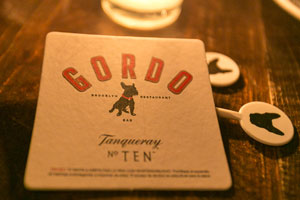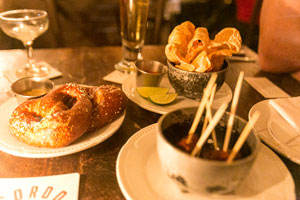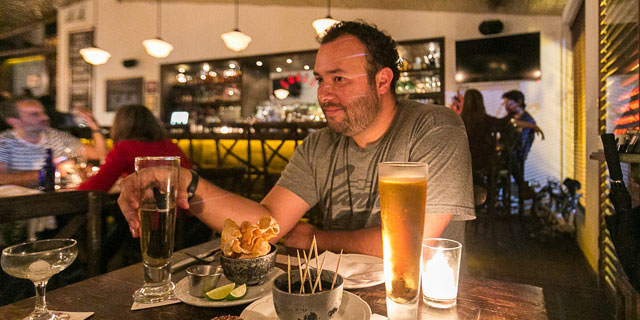Chef Daniel Castaño is not happy. The local brewery that had been making craft beers for him has suddenly gone out of business leaving customers with no choice but mass produced brews. The Colombian-born chef grudgingly acknowledges that he probably wouldn’t be dealing with that particular problem if he’d opened a bar and bistro in his adopted home of Brooklyn instead of bringing Brooklyn to Bogota.
The 36-year-old, who was born in Medellin but grew up in Bogota and then the United States, says the most challenging moment of his career, so far, is not the closing of the brewery but the task of telling his parents that he was leaving engineering school to become a chef. “I knew I wanted to become a chef when I realized that I really enjoyed food,” says Castaño. “I cooked for myself a lot when I was a kid and I took a lot of cues from my grandmother.”
He picked up more cues during his training at the French Culinary Institute in New York City (now the International Culinary Center) and during the eight years he worked for Mario Batali, which included stints at Lupa, Babbo, and Quality Meats, as well as roles as Sous Chef at Otto Enoteca Pizzeria and Executive Chef at the Italian Wine Merchants. Castaño also worked in Cataluña on a self-imposed steep learning curve about Spanish food.
In 2007 he quit his job with Batali’s “Pasta Research” operation, ready for something new. “The day I quit I got a call from someone in Bogota who had a friend who wanted to open a restaurant,” says Castaño. That partnership resulted in his first solo restaurant, an Italian place in Bogota called Emilia Romagna that’s still thriving. The partnership thrived too and Castaño went on to open the acclaimed Vera restaurant in the swanky Tcherassi Hotel & Spa in Cartagena; Julia, a Neapolitan-style pizzeria in Bogota; and Lucia in Medellin (a restaurant he’s no longer affiliated with).
Next, Castaño brings New York to Colombia… [pagebreak]
Even with four restaurants open for business in Colombia, Castaño never left the US. Instead, he’d spend the first six months to a year at each new restaurant to establish the cuisine and the operating procedures and to train staff who ultimately took over day-to-day operations once Castaño returned home to Brooklyn.
After 12 years in the US, however, Castaño felt the time was right to return to Colombia. “Colombia is going through a great time right now economically, socially, and politically,” Castaño says. He wanted to be part of the resurgence.
“When I moved from Brooklyn to Bogota I was really missing the neighborhood bars where you can  get a great cocktail and a great burger,” he says. So he opened one. In late 2012 Castaño’s newest restaurant, Gordo Brooklyn Restaurant & Bar served its first customers. The place is named after the rescue dog he brought with him from Brooklyn who, in turn, is named after the Spanish word for fat, which is often used as an intimate term of affection. Though located in the Zona G area of Bogota where it’s surrounded by some of the city’s best eateries, Gordo is in a class by itself.
get a great cocktail and a great burger,” he says. So he opened one. In late 2012 Castaño’s newest restaurant, Gordo Brooklyn Restaurant & Bar served its first customers. The place is named after the rescue dog he brought with him from Brooklyn who, in turn, is named after the Spanish word for fat, which is often used as an intimate term of affection. Though located in the Zona G area of Bogota where it’s surrounded by some of the city’s best eateries, Gordo is in a class by itself.
The design and décor instantly channel Brooklyn with pressed tin ceilings actually brought from Brooklyn; a long, welcoming bar with comfortable seats; and flattering lighting and enticing corners furnished with chic, slouchy couches ordered from Restoration Hardware. It’s almost shocking to hear Spanish instead of English in such a setting.
While the casually hip hang out vibe is pure Brooklyn, the food and drink is pure Castaño, inspired by his many influences. “Who you are is defined by your upbringing and your life experiences,” the chef says. “In my case, living in the US and Colombia and Spain and all the other wonderful places, people and cultures I’ve been able to experience have influenced what I like.”
Next, what the future holds for the chef… [pagebreak]
What he likes are artisanal cocktails and sophisticated takes on classics. Among these is a gin martini and sidecar combination with a generous dose of house made vermouth. It's pleasingly complex but does not mask the gin. Tonic water will also soon be made in house, and bar staff have four different types of ice cubes to work with, including enormous rocks that resist melting in tumblers of rum or whiskey, slender rectangles for tall drinks, and transparent bucket cubes made in a special machine that prevents the formation of bubbles and hand chopped ice. At around $10 each, the drinks at Gordo are some of the best cocktail bargains in Bogota.
 Of course, there’s a burger on the menu and it’s Gordo’s best seller. But even that bar basic has been amped up with three kinds of un-aged beef hand ground daily, a house baked brioche bun and Heinz 57 catsup, Guldens mustard, and Kewpi mayonnaise from Japan on the side. Shared plates include house spiced nuts, baked to order pretzels, and an invention called pork belly tater tots. The "tots" are made with a Colombian favorite, pork belly, slow cooked for 12 hours, then formed into tater tot shape (there is no potato in this recipe) and fried into crunchy, succulent morsels. The light aoli that comes with a plate of rich grilled artichoke hearts is made with egg whites and garlic, just the way Castaño learned to make it in Spain.
Of course, there’s a burger on the menu and it’s Gordo’s best seller. But even that bar basic has been amped up with three kinds of un-aged beef hand ground daily, a house baked brioche bun and Heinz 57 catsup, Guldens mustard, and Kewpi mayonnaise from Japan on the side. Shared plates include house spiced nuts, baked to order pretzels, and an invention called pork belly tater tots. The "tots" are made with a Colombian favorite, pork belly, slow cooked for 12 hours, then formed into tater tot shape (there is no potato in this recipe) and fried into crunchy, succulent morsels. The light aoli that comes with a plate of rich grilled artichoke hearts is made with egg whites and garlic, just the way Castaño learned to make it in Spain.
Ingredients that Castaño can’t find in local markets he has grown just for him. These include basil, eggs, chickens, and tomatoes raised from seeds he brought back from Italy. Not that any of that is noticed by Gordo patrons, most of whom simply think the food tastes great. That’s okay with Castaño who says “every time I see someone eating at the bar, I smile.”
Now, if he can just find another local brewery to make him some beer…


![Making Mealtime Matter with La Familia: Easy Sofrito [Video]](https://thelatinkitchen.com/wp-content/uploads/2015/10/sofrito-shutterstock__0-500x383.jpg)
![Easy Latin Smoothies: Goji Berry Smoothie [Video]](https://thelatinkitchen.com/wp-content/uploads/2015/12/goji_berry-shutterstock_-500x383.jpg)
















![Fun and Fast Recipes: Fiesta Cabbage Salad [Video]](https://thelatinkitchen.com/wp-content/uploads/2015/11/fiesta_cabbage_slaw-shutterstock_-500x383.jpg)









